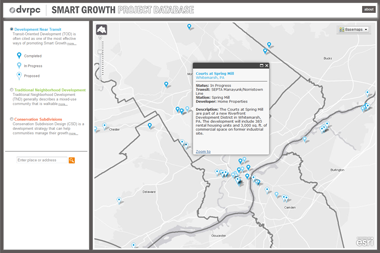Smart Growth is an approach to land use and development that seeks to protect the natural environment and make cities, towns, and neighborhoods in Greater Philadelphia economically stronger, socially diverse, and resilient to climate change. Smart Growth planning prioritizes investment in existing urban centers and older communities with existing infrastructure rather than the development of open space and farmland into suburban sprawl. DVRPC’s Office of Smart Growth works with partners throughout the region to promote land use and transportation planning that results in compact, mixed-use development, diverse housing and transportation options, and meaningful community engagement.
Transit-Oriented Development (TOD)
TOD refers to compact, mixed-use development located within walking distance of a transit station. Its pedestrian-oriented design encourages residents and workers to drive their cars less and ride transit more. DVRPC prepares TOD plans while also tracking proposed, in progress and completed TODs.
Plans And Resources
Learn more about DVRPC-led studies on revitalization, livability, traffic calming and multi-municipal planning, along with other local and national resources.
Municipal Adoption Of Smart Growth Tools
Municipal planning and land use regulations play a critical role in achieving the goals outlined in DVRPC's Long-Range Plan. DVRPC completed a comprehensive survey of Smart Growth tools presently used in the region, through surveying municipalities and gathering feedback from the nine County Planning Commissions/Departments.
Project Database

The Smart Growth Project Database is an online mapping application that tracks a variety of noteworthy development projects generally constructed between 2010 and 2020. The application focuses on three types of Smart Growth projects: developments near transit, traditional neighborhood developments (TND), and conservation subdivisions. Although the database is no longer being updated, the projects featured here can serve as an important resource for local officials, planners, and citizens interested in regional real estate development trends.
Shared Services
Governments that share services have lower per capita expenses than those that do not and this effect is most pronounced in suburban communities. In the DVRPC region, there are many examples of service sharing; it has been embraced by members of both political parties as a fiscally responsible method of service delivery. While there are differing definitions of what constitutes shared services, DVRPC defines them as those provided by or received by more than one municipality.
Transit Revitalization Investment District (TRID)
In Pennsylvania, TRID is legislation that offers municipalities, transit agencies, and developers a flexible approach to plan for and implement TOD. TRID is an optional tool that could be used by Pennsylvania communities wishing to leverage state funding. It encourages the use of financing mechanisms such as public-private partnerships and shared tax revenues. DVRPC has collected a number of example plans from the region and additional resources to aid communities in thinking about using TRID.
Immigration
Greater Philadelphia's population is becoming more diverse. Immigration has helped many communities in the region replenish population losses.